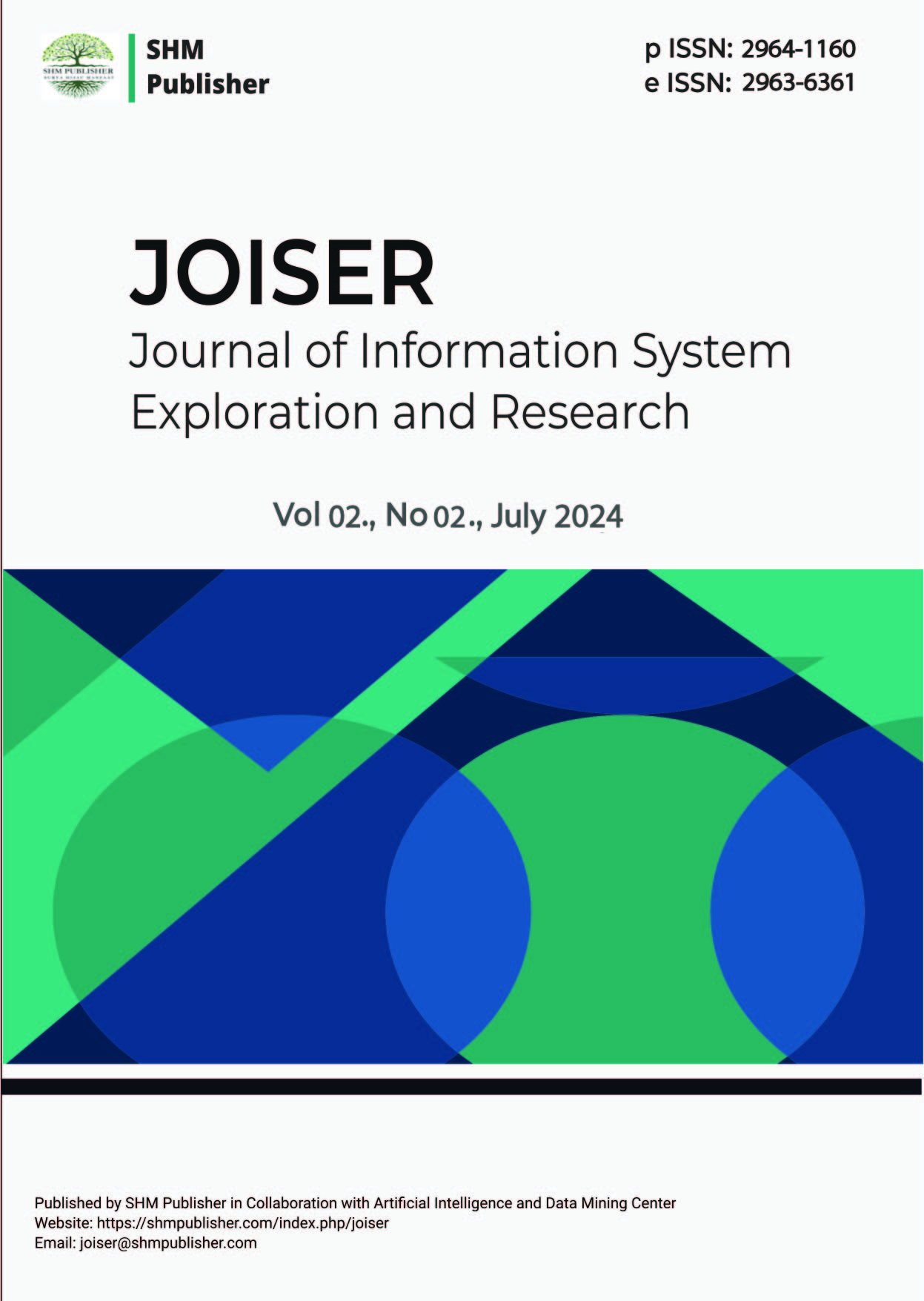Breast Cancer Diagnosis Utilizing Artificial Neural Network (ANN) Algorithm for Integrating Multi-Omics Data and Clinical Features
Main Article Content
Abstract
Breast cancer is one of the most common diseases affecting women worldwide, with a significant impact on patient's health and quality of life. Despite advances in medical technology and research, breast cancer diagnosis remains a challenge due to its complexity involving various biological and clinical factors. Several previous studies have focused on detecting this disease with optimal accuracy, but the selection of appropriate algorithms and methods is key to achieving this goal. This study aims to improve the accuracy of breast cancer diagnosis by using the ANN algorithm and data balancing method, SMOTE. This research uses Multi-Omic data and Clinical Features obtained in general from Kaggle. The research process is carried out in several stages, namely Data Collection, Preprocessing, Oversampling, Modeling, and Evaluation. This research successfully obtained an increase in accuracy, which was able to achieve an accuracy of 99.30%. This research shows that early detection of breast cancer with ANN algorithm and data balancing using SMOTE can improve accuracy performance in early detection of breast cancer. Given the use of data in this study is not too large, it is recommended for further research to use a larger dataset to validate the strength of the model that has been built on more varied data.
Article Details

This work is licensed under a Creative Commons Attribution-ShareAlike 4.0 International License.
References
Z. He, J. Zhang, X. Yuan, and Y. Zhang, “Integrating Somatic Mutations for Breast Cancer Survival Prediction Using Machine Learning Methods,” Front. Genet., vol. 11, no. January, pp. 1–12, 2021, doi: 10.3389/fgene.2020.632901.
A. Tayanloo-Beik et al., “OMICS insights into cancer histology; Metabolomics and proteomics approach,” Clin. Biochem., vol. 84, no. April, pp. 13–20, 2020, doi: 10.1016/j.clinbiochem.2020.06.008.
A. C. Gamboa, A. Gronchi, and K. Cardona, “Soft‐tissue sarcoma in adults: An update on the current state of histiotype‐specific management in an era of personalized medicine,” CA. Cancer J. Clin., vol. 70, no. 3, pp. 200–229, 2020, doi: 10.3322/caac.21605.
American Cancer Society, “American Cancer Society. Cancer Facts & Figures 2021. Atlanta: American Cancer Society; 2021.” pp. 1–72, 2021.
L. Tong, J. Mitchel, K. Chatlin, and M. D. Wang, “Deep learning based feature-level integration of multi-omics data for breast cancer patients survival analysis,” BMC Med. Inform. Decis. Mak., vol. 20, no. 1, pp. 1–12, 2020, doi: 10.1186/s12911-020-01225-8.
M. M. Islam, M. R. Haque, H. Iqbal, M. M. Hasan, M. Hasan, and M. N. Kabir, “Breast Cancer Prediction: A Comparative Study Using Machine Learning Techniques,” SN Comput. Sci., vol. 1, no. 5, pp. 1–14, 2020, doi: 10.1007/s42979-020-00305-w.
S. H. Park and K. Han, “Methodologic guide for evaluating clinical performance and effect of artificial intelligence technology for medical diagnosis and prediction,” Radiology, vol. 286, no. 3, pp. 800–809, 2018, doi: 10.1148/radiol.2017171920.
K. T. Chui et al., “Transfer Learning-Based Multi-Scale Denoising Convolutional Neural Network for Prostate Cancer Detection,” Cancers (Basel)., vol. 14, no. 15, 2022, doi: 10.3390/cancers14153687.
I. Zenbout, A. Bouramoul, S. Meshoul, and M. Amrane, “Efficient Bioinspired Feature Selection and Machine Learning Based Framework Using Omics Data and Biological Knowledge Data Bases in Cancer Clinical Endpoint Prediction,” IEEE Access, vol. 11, no. October 2022, pp. 2674–2699, 2023, doi: 10.1109/ACCESS.2023.3234294.
S. I. Ayon, M. M. Islam, and M. R. Hossain, “Coronary Artery Heart Disease Prediction: A Comparative Study of Computational Intelligence Techniques,” IETE J. Res., vol. 68, no. 4, pp. 2488–2507, 2022, doi: 10.1080/03772063.2020.1713916.
M. R. Haque, M. M. Islam, H. Iqbal, M. S. Reza, and M. K. Hasan, “Performance Evaluation of Random Forests and Artificial Neural Networks for the Classification of Liver Disorder,” Int. Conf. Comput. Commun. Chem. Mater. Electron. Eng. IC4ME2 2018, pp. 1–5, 2018, doi: 10.1109/IC4ME2.2018.8465658.
C. Boeri et al., “Machine Learning techniques in breast cancer prognosis prediction: A primary evaluation,” Cancer Med., vol. 9, no. 9, pp. 3234–3243, 2020, doi: 10.1002/cam4.2811.
S. Wang, S. Wang, and Z. Wang, “A survey on multi-omics-based cancer diagnosis using machine learning with the potential application in gastrointestinal cancer,” Front. Med., vol. 9, 2023, doi: 10.3389/fmed.2022.1109365.
G. Nicora, F. Vitali, A. Dagliati, N. Geifman, and R. Bellazzi, “Integrated Multi-Omics Analyses in Oncology: A Review of Machine Learning Methods and Tools,” Front. Oncol., vol. 10, no. June, 2020, doi: 10.3389/fonc.2020.01030.
Y. H. Chuang et al., “Convolutional neural network for human cancer types prediction by integrating protein interaction networks and omics data,” Sci. Rep., vol. 11, no. 1, pp. 1–10, 2021, doi: 10.1038/s41598-021-98814-y.
E. Lin and H. Y. Lane, “Machine learning and systems genomics approaches for multi-omics data,” Biomark. Res., vol. 5, no. 1, pp. 1–6, 2017, doi: 10.1186/s40364-017-0082-y.
P. S. Reel, S. Reel, E. Pearson, E. Trucco, and E. Jefferson, “Using machine learning approaches for multi-omics data analysis: A review,” Biotechnol. Adv., vol. 49, no. December 2020, p. 107739, 2021, doi: 10.1016/j.biotechadv.2021.107739.
D. Leng et al., “A benchmark study of deep learning-based multi-omics data fusion methods for cancer,” Genome Biol., vol. 23, no. 1, pp. 1–32, 2022, doi: 10.1186/s13059-022-02739-2.
N. Biswas and S. Chakrabarti, “Artificial Intelligence (AI)-Based Systems Biology Approaches in Multi-Omics Data Analysis of Cancer,” Front. Oncol., vol. 10, no. October, pp. 1–13, 2020, doi: 10.3389/fonc.2020.588221.
R. Oktafiani, A. Hermawan, and D. Avianto, “Pengaruh Komposisi Split data Terhadap Performa Klasifikasi Penyakit Kanker Payudara Menggunakan Algoritma Machine Learning,” J. Sains dan Inform., vol. 9, no. April, pp. 19–28, 2023, doi: 10.34128/jsi.v9i1.622.
Y. Amelia, P. Eosina, and F. A. Setiawan, “Perbandingan Metode Deep Learning Dan Machine Learning Untuk Klasifikasi (Ujicoba Pada Data Penyakit Kanker Payudara),” Inova-Tif, vol. 1, no. 2, p. 109, 2018, doi: 10.32832/inova-tif.v1i2.5449.
Jumanto et al., “Optimizing Support Vector Machine Performance for Parkinson’s Disease Diagnosis Using GridSearchCV and PCA-Based Feature Extraction,” J. Inf. Syst. Eng. Bus. Intell., vol. 10, no. 1, pp. 38–50, 2024, doi: 10.20473/jisebi.10.1.38-50.
M. Ridwan, I. Sembiring, A. Setiawan, and I. Setyawan, “Analysis of Attack Detection on Log Access Servers Using Machine Learning Classification: Integrating Expert Labeling and Optimal Model Selection,” Sci. J. Informatics, vol. 11, no. 1, pp. 119–126, 2024, doi: 10.15294/sji.v11i1.49424.

